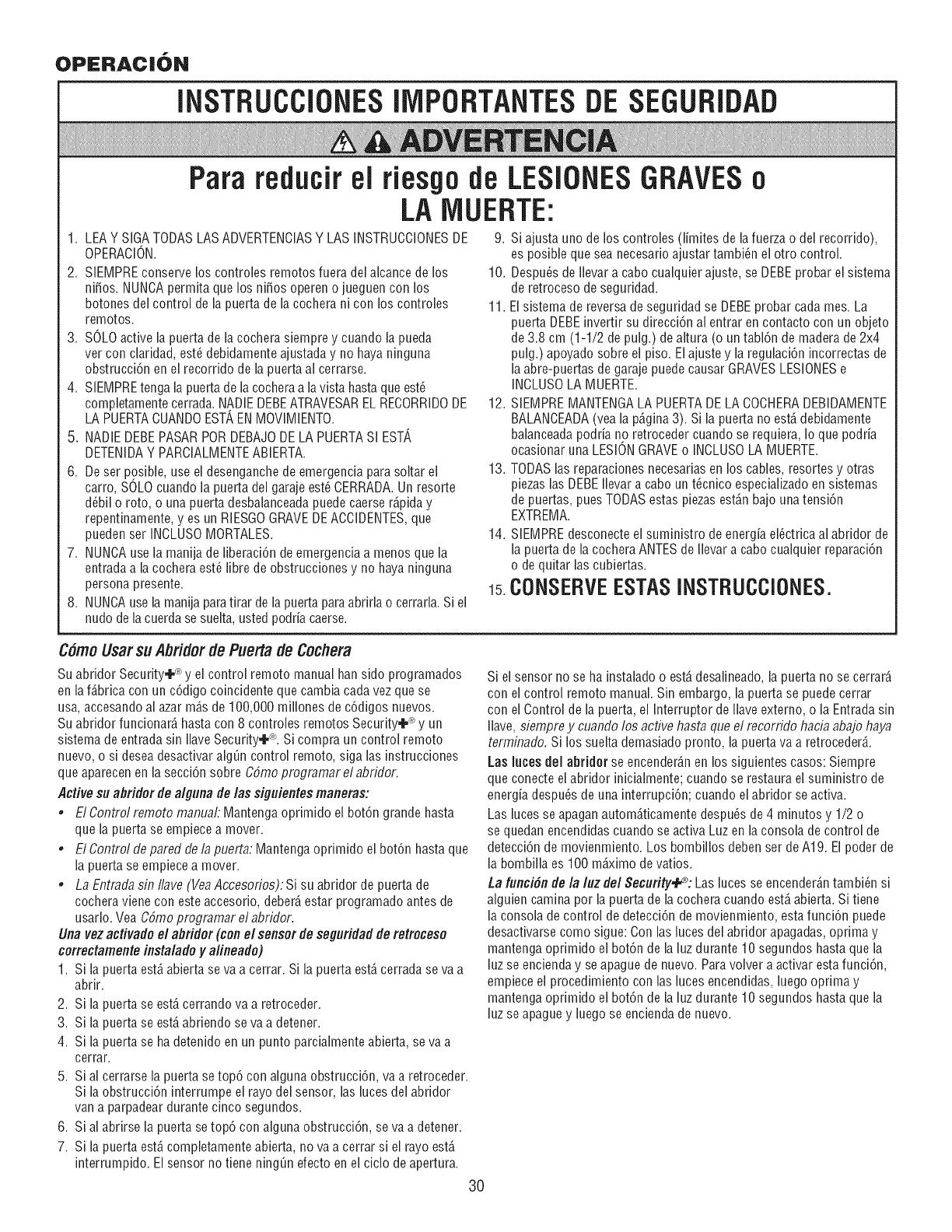
OPERAC|ON
INSTRUCCIONESllViPORTANTESDESEGURIDAD
Para reducirel riesgode LESiONESGRAVESo
LAMUERTE:
1. LEAY SIGATODASLASADVERTENCIASY LAS INSTRUCCIONESDE 9. Si ajusta unode los controles (l[mites de lafuerza odel recorrido),
OPERAClON. es posibleque sea necesarioajustar tambi_n el otto control.
2. SIEMPREconservelos controles remotos fuera delalcancede los
ni_os. NUNCApermita que los ni_os operen ojueguen con los
botonesdel control de la puerta de lacocherani con los controles
remotos.
3. SOLOactive la puerta de lacocherasiempre y cuando la pueda
ver con claridad, est_ debidamenteajustaday no hayaninguna
obstrucci6n enel recorrido de la puertaal cerrarse.
4. SIEMPREtengala puertade la cocheraa lavista hastaqueest_
completamentecerrada.NADIEDEBEATRAVESARELREOORRIDODE
LAPUERTACUANDOEST',ENMOVIMIENTO.
5. NADIEDEBEPASARPORDEBAJODELA PUERTASI EST',
DETENIDAY PARCIALMENTEABIERTA.
6. Deser posible, useel desenganchede emergenciapara soltar el
carro, SOLOcuando la puerta delgaraje est_ CERRADA.Un resorte
d_bil o roto, o unapuertadesbalanceadapuedecaerse r_,piday
repentinamente,y es un RIESGOGRAVEDEACCIDENTES,que
puedenser INCLUSOMORTALES.
7. NUNCAusela manijade fiberaci6n deemergenciaa menos quela
entrada a la cochera est_ fibrede obstrucciones y no hayaninguna
personapresente.
8. NUNCAusela manijaparatirar dela puertaparaabrirla o cerrarla.Si el
nudode la cuerdasesuelta,ustedpodriacaerse.
10. Despu@sde Ilevaracabocualquier ajuste, seDEBEprobar el sistema
de retroceso deseguridad.
11. El sistema de reversade seguridad se DEBEprobar cadames. La
puerta DEBEinvertirsu direcci6n al entrar en contacto con un objeto
de 3.8 cm (1-1/2 de pulg.) dealtura (o untaN6n de maderade 2x4
pulg.) apoyado sobre elpiso. Elajuste y la regulaci6n incorrectas de
la abre-puertas degaraje puede causar GRAVESLESIONESe
INCLUSOLA MUERTE.
12. SIEMPREMANTENGALA PUERTADE LACOCHERADEBIDAMENTE
BALANCEADA(veala p6,gina3). Si la puertano est,, debidamente
balanceadapodria no retroceder cuando se requiera, Ioque podria
ocasionar una LESIONGRAVEo INCLUSOLA MUERTE.
13. TODASlas reparaciones necesariasen los cables,resortes y otras
piezas las DEBEIlevaracaboun t_cnico especializadoen sistemas
de puertas, puesTODASestas piezasest_,nbajo unatensi6n
EXTREMA.
14. SIEMPREdesconecteel suministro de energiael_ctrica al abridor de
la puertade lacocheraANTESde Ilevaracabo cualquier reparaci6n
o de quitar lascubiertas.
15.CONSERVEESTASINSTRUCCIONES.
C#moUsarsuAbfidordePuertade Cochera
Suabridor Security÷_ y el control remoto manual hansido programados
en laf_,bricacon un c6digo coincidente que cambia cadavezquese
usa, accesandoal azarm_,sde 100,000 millones de c6digos nuevos.
Suabridor funcionar_,hasta con 8controles remotos Security÷ _*y un
sistema de entradasin IlaveSecurity÷_L Si compra un control remoto
nuevo, o si deseadesactivaralg_n control remoto, siga las instrucciones
queaparecenen la secci6n sobre C6mo programar el abridor,
Activesu abridordealgunade las siguientes maneras:
, El Control remoto manual: Mantengaoprimido el bot6n grande hasta
que la puertase empiecea mover.
, El Control de paredde lapuerta: Mantengaoprimido el bot6n hastaque
la puerta seempiece a mover.
, La Entradasin/lave (VeaAccesorios): Si su abridor de puerta de
cocheraviene con este accesorio, deber_,estar programado antesde
usarlo. VeaC6moprogramar el abridor.
Llnavez activado el abfidor (con el sensor de seguridad deretroceso
correctamente instaladoy alineado)
1. Si la puertaest,, abiertasevaa cerrar. Si la puerta est,,cerrada seva a
abrir.
2. Si la puertase est,,cerrando va a retroceder.
3. Si la puertase est,,abriendo se vaadetener.
4. Si la puertase hadetenido en un punto parcialmenteabierta, se va a
cerrar.
5. Sial cerrarse la puerta setop6 con alguna obstrucci6n, vaaretroceder.
Si laobstrucci6n interrumpe elrayo del sensor, las lucesdel abridor
vana parpadear durante cinco segundos.
6. Sial abrirse la puertasetop6 con alguna obstrucci6n, sevaa detener.
7. Si la puertaest,, completamenteabierta, no vaa cerrar si el rayoest,,
interrumpido. Elsensor notiene ning_n efecto enel ciclo de apertura.
Si el sensor no seha instalado o estb,desalineado,la puertano se cerrarb,
con elcontrol remoto manual.Sin embargo, la puerta sepuede cerrar
con elControl de lapuerta, el Interruptor de Ilaveexterno, o la Entradasin
Ilave, siemprey cuando los active hasta que el recorrido haciaabajo haya
terminado. Si los suelta demasiado pronto, lapuertava a retroceder_,.
Las laces del abridor se encender_,nen los siguientes casos: Siempre
queconecte elabridor inicialmente; cuando se restaura el suministro de
energiadespu_s de unainterrupci6n; cuando ei abridor seactiva.
Las iucesse apaganautom_.ticamentedespu_sde 4 minutos y 1/2 o
sequedan encendidascuando seactiva Luz en laconsolade control de
detecci6n de movienmiento. Los bombillos debenser de A19. El poderde
la bombiila es 100 m6,ximodevatios.
La funci#n de la luz del Security÷°: Las luces seencender_,ntambi_n si
alguien camina por la puerta de la cocheracuando est,. abierta.Si tiene
la consola de control de detecci6nde movienmiento, estafunci6n puede
desactivarsecomo sigue: Conlas lucesdel abridor apagadas,oprima y
mantengaoprimido el bot6n de la luz durante 10 segundos hastaque la
luz se encienday seapague de nuevo.Paravolver aactivar estafunci6n,
empiece el procedimiento con las luces encendidas,luego oprima y
mantengaoprimido el bot6n de la luz durante 10 segundos hastaque la
luz se apaguey luegose enciendade nuevo.
30











































































